Lesson 3: Describing Quantitative Data (Shape & Center)
Optional Videos for this Lesson
Part 1
Part 2
Part 3
Lesson Outcomes
By the end of this lesson, you should be able to:
- Create a histogram from data
- Interpret data presented in a histogram
- Identify left-skewed, right-skewed, and symmetric distributions from histograms
- Calculate the mean, median, and mode for quantitative data using software
- Compare the centers of distributions using graphical and numerical summaries
- Describe the effects that skewness or outliers have on the relationship between the mean and median
- Distinguish between a parameter and a statistic
Review of the Five Steps of the Statistical Process
We will use the five steps in the Statistical Process throughout the course. Recall the five steps (and the mnemonic “Daniel Can Discern More Truth) before you begin this lesson.
|
Step 1: |
Daniel |
Design the study |
|---|---|---|
|
Step 2: |
Can |
Collect data |
|
Step 3: |
Discern |
Describe the data |
|
Step 4: |
More |
Make inferences |
|
Step 5: |
Truth |
Take action |

Shape of a Distribution
Cost to Treat Tuberculosis in India
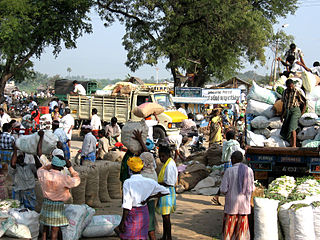

Step 1: Design the
study.
Tuberculosis (TB) is the deadliest bacterial disease in the world. In 2009, nine million new cases of tuberculosis were diagnosed, leading to almost 2 million deaths worldwide. Currently, the principal vaccine used to prevent tuberculosis is Bacille Calmette Guerin (BCG). Unfortunately, BCG is only moderately effective at preventing tuberculosis. Historically, India has had a high number of tuberculosis cases. The Indian Government wants to reduce the prevalence of this disease.
In this activity, you will compare the average costs of treating a person who contracts tuberculosis to the costs of preventing a case of tuberculosis in India.

Step 2: Collect
data.
Health Care records of tuberculosis patients in India were surveyed to estimate the cost to treat patients with tuberculosis. The following data are representative of the total costs (in US dollars) incurred by society in the treatment of 10 randomly selected tuberculosis patients in India.
These costs include health care treatment, time missed from work, and in some cases utility lost due to death.

Step 3: Describe the
data.
Visualizing Quantitative Data: Histograms
The following data are representative of the total costs (in US dollars) incurred by society in the treatment of 10 randomly selected tuberculosis patients in India.
To help us visualize these data, we will create a graph called a histogram. To make a histogram, we will divide the number line from 0 to 35,000 in seven equal parts. We will then count the number of data points in each of these intervals:
|
Interval |
Number of Observations |
|---|---|
|
At least 0 and less than 5,000 |
2 |
|
At least 5,000 and less than 10,000 |
1 |
|
At least 10,000 and less than 15,000 |
3 |
|
At least 15,000 and less than 20,000 |
2 |
|
At least 20,000 and less than 25,000 |
1 |
|
At least 25,000 and less than 30,000 |
0 |
|
At least 30,000 and less than 35,000 |
1 |
For each of these intervals, called bins, we draw a bar on the histogram. The width of the bars is determined by the width of the bin (5000 in this example). The height of the bars is equal to the number of observations that fall in each bin. As we look at the histogram shown below, we see bars ranging from $0 to $35,000. We also see higher bars in the middle between $10,000 to $20,000 show that these values are more commonly occurring than the other values. If we computed the average of the values contained in our histogram, we would compute the number \[ \frac{15,100 + 19,000 + 4,800 + 6,500 + 14,900 + 600 + 23,500 + 11,500 + 12,900 + 32,200}{10} = 14,100 \] showing that the center of the histogram (or average) is at $14,100.
You can watch this short video of how to create a histogram in Excel, or follow these steps:
Step 1
Start by typing the data into a column of cells in Excel: each data point into its own cell, as shown below. Then highlight the data.
Step 2
Go to the Insert ribbon in Excel and select the histogram icon from the “Charts” section of the ribbon. Then select the first option of histograms presented.
You will notice that the histogram does not look much like the histogram above yet. The number and size of bins in a histogram can drastically change the apparent shape of the distribution. It is worth experimenting with a different number of bins so the true shape of the distribution of data is revealed. To change the number of bins go on to the next steps.
Step 3
Be sure the graph is selected, so that you can select the “Format” ribbon. In the upper left corner of the ribbon, select “Horizontal Category Axis” in the drop down box. Then click on “Format Selection”
Step 4
A menu of options will open on the right side of the screen. You can adjust the bin width or number of bins. In this case, though we can’t make it match, in order to make the histogram look as much as possible like the one shown above, we will choose a bin width of 5000.
Excel shows the starting and ending values for each bin. For example, the first bin goes from 600 up to 5,600. We see there are two data points contained in that bin, represented by the bin’s bar height. The next bin contains only one of our data points, it includes any value greater than 5,600 up through, and including, 10,600. And so on.
This histogram does not look exactly like the histogram pictured above, but it is close. To make it match exactly you can use the “Overflow bin” and “Underflow bin” options; but that is beyond what we will discuss here.
Making Inference About the Population
After summarizing the data from our sample of the populations both
numerically and graphically, we can use this information to make
inference about the full population.

Step 4: Make
inferences.
In the past, the total average cost to society to treat a case of tuberculosis in India was known to be $13,800. As shown in our Step 3 calculations, the 10 randomly selected patients showed an average cost that was higher than the historic value at $14,100. This might make us believe that the actual total average cost to society is also $14,100. However, in depth statistical calculations (that you will be taught how to do later this semestr) show that there is a 46% chance that our sample had an average of $14,100 just by random chance. This isn’t too hard to believe since we only had a sample size of 10 people, and $14,100 is only $300 above $13,800, so it turns out to be fairly likely (46% chance) that because of random chance our sample had an average that was a little higher than the actual value from the population. So we will conclude that the total average cost to society is still essentially the same as it has been in the past.

Step 5: Take
action.
After making inferences, you take action. The motivation for conducting a study like this is usually to see if there is inflation in the costs.
- Given our conclusion in Step 4 (that the results of our random sample being at an average $14,100 had a 46% probability of just being caused by random chance) do you think the Government of India needs to take any special action to stop the increase in the cost to treat tuberculosis?
One benefit of using a histogram is that it allows you to visualize the distribution of the data. A histogram illustrates the overall shape of the distribution of the data. The height of the bars show how many observations fall in that range.
We will describe the shape of the distribution of a data set using the following basic categories: symmetric, bell-shaped, skewed right, and skewed left. Additionally, we can label the shape of a distribution as uniform, unimodal, bimodal, or multimodal.
A distribution is symmetric if both the left and right side of the distribution appear to be roughly a mirror image of each other. A special symmetric distribution is a bell-shaped distribution. When data follow a bell-shaped distribution, the histogram looks like a bell. Bell-shaped distributions play an important role in Statistics and will play a role in most of the future lessons.
A distribution is right-skewed if a histogram of the distribution shows a long right tail. This can occur if there are some very large outliers on the right-hand side of the distribution. A distribution is left-skewed if a histogram shows that it has a long tail to the left.
| Right-skewed | Symmetric & Bell-shaped | Left-skewed |
|---|---|---|
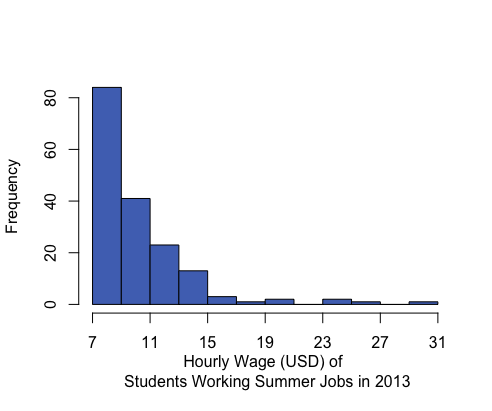
|
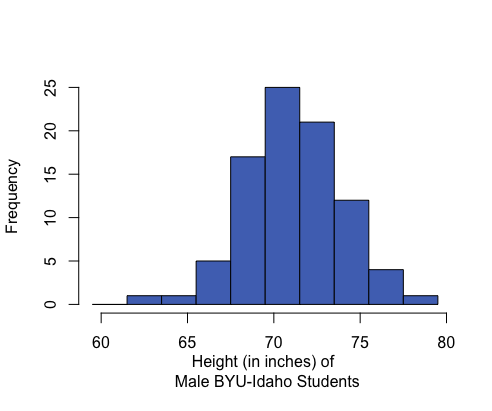
|
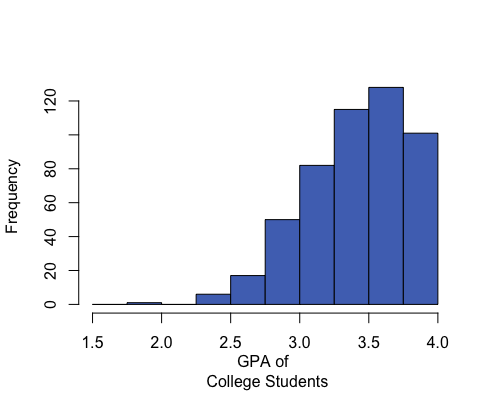
|
|
Mean: $10.45 Median: $9.04 Mean is to the right of the median. |
Mean: 71.1 inches Median: 71 inches Mean and median are roughly equal. |
Mean: 3.42 Median: 3.45 Mean is to the left of the median. |
If a distribution has only one peak, it is said to be unimodal. The three distributions illustrated above are all unimodal distributions. Some people might argue that there are several peaks in the GPA data, so it should not be considered unimodal. Even though there are jagged bumps in the histogram, it is important to visualize the overall shape in the data. When interpreting a histogram, it can be helpful to blur your eyes and imagine the overall shape after smoothing out the bumps. If the overall trend indicates that there is more than one bump, then we do not consider the distribution to be unimodal. We will usually only work with unimodal data sets in this course.
Some distributions have no distinct peak, others have more than one peak. When there is no distinct peak, and the histogram shows a relatively flat shape, we might say the data follow a uniform distribution. If there are two distinct peaks, a distribution is called bimodal. If there are more than two peaks, we refer to the distribution as multimodal.
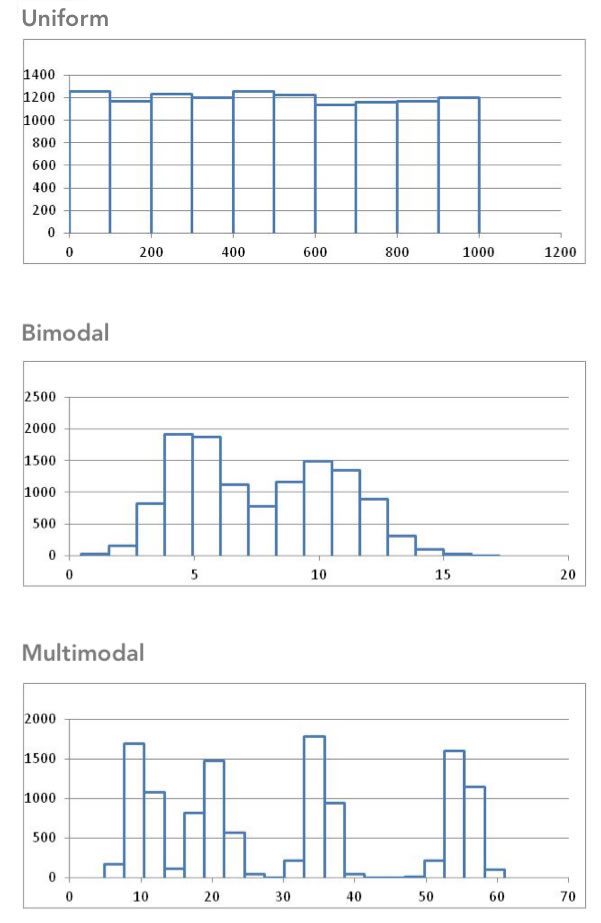
Center of a Distribution

Step 3: Describe the data.
Sometimes people talk about the “typical” BYU-Idaho student or the average waiting time for a bus. But what does it mean for something or someone to be “average?” How can we quantify what it means to be typical or average? In the example below, we will explore one way to define what “average” means.
When we talk about the “typical” or “average” value, we are essentially describing the center of a population. If we want to estimate the “average” costs to treat a tuberculosis patient, there are several ways we can do it.
Measuring the Center of a Distribution
Mean
The sample mean or sample arithmetic mean is the most common tool to estimate the center of a distribution. It is referred to simply as the mean. It is computed by adding up the observed data and dividing by the number of observations in the data set.
In Statistics, important ideas are given a name. Very important ideas are given a symbol. The sample mean has both a name (mean) and a symbol (\(\bar x\), called “x-bar”).
\[ \bar{x} \text{ is used to denote the sample mean} \]
You may have heard people refer to the sample mean as the average. Technically, the word average refers to any number that is used to estimate the center of a distribution. The mean, median and mode are all examples of “averages.” To avoid confusion, it is best to use the words mean, median, and mode instead of the word average, so that it is clear which “average” your are referencing.
- Practice finding the mean, \(\bar x\), for the tuberculosis treatment costs of the 10 patients in India by simplifying the following: \[\bar x=\frac{15100 + 19000 + 4800 + 6500 + 14900 + 600 + 23500 + 11500 + 12900 + 32200}{10}=\]
Median
The median is the middle value in a sorted data set. Half of the observations in the data set are below the median and half are above the median. To find the median, you:
- Sort the values from smallest to largest
- Do one of the following:
- If there are an odd number of values, the median is the middle value in the sorted list.
- If there are an even number of values, the median is the mean of the two middle values in the sorted list.
- Do one of the following:
- Practice finding the median of the tuberculosis treatment costs for the 10 patients in India. First, sort the data from smallest to largest.
- Since there are an even number of observations (n=10), the median is computed as the mean of the middle two values. Use your answer to the previous question to find the median of the data. What is the median?
Mode
The most frequently occurring value is called the mode. Sometimes there is more than one mode. For example, in the data set
\[{1,~~2, ~~2, ~~2, ~~3, ~~4, ~~4, ~~5, ~~5, ~~5, ~~6}\]
the modes are 2 and 5. Both of these values occur three times, which is more times than any other value.
If no number occurs more than once in the data set, we say that there is no mode. For the data set representing the costs to treat tuberculosis in India, none of the values is repeated. So, there is no mode for these data.
- For a particular data set, which of the following can occur?
There may be no mode.
There may be exactly one mode.
There may be several modes.
Only A and B can occur.
A, B, and C can all occur.
Excel Instructions for Mean, Median, and Mode
To calculate most numerical summaries (such as the mean, median, and mode) in Excel, follow these general steps:
Open Excel.
Enter the data into Excel. There should only be one data value per cell.
Next, in the cell where you would like to store the numerical summary type an “=”, followed by the name of the function and then an open parenthesis, “(”.
Then, highlight the data (by clicking on it) to which you want to apply the function. The cell reference range will automatically be added to your formula. Then type a closed parenthesis, “)” and hit enter.
Caculate a Mean
For example, to calculate the mean of the sample of tuberculosis patient costs in India:
- put the data in Excel,
- in a blank cell type “=AVERAGE(”,
- highlight the data,
- close the parenthesis with “)” before hitting enter:
Notice that Excel calles the “mean” the “average.”
Calculate a Median
Simply replace the word “AVERAGE” in the formula with the word “MEDIAN”. Try it with the tuberculosis patient data, you should get the same value that was calculated by hand above.
Calculate a Mode
Similarly, to calculate a mode, replace the word “AVERAGE” in the formula with the word “MODE” or “MODE.SNGL”. NOTE: If you try this on the tuberculosis patient data, you will get a result of “#N/A”. This is Excel’s way of saying that a mode does not exist because there are no repeated values in the dataset.
Parameters and Statistics
We only have data on the cost to treat ten randomly selected tuberculosis patients. This represents a random sample from the population. The sample obtained by the researchers depends on random chance. If the study was repeated and a new sample of ten patients was randomly drawn from all cases of tuberculosis in India, would we observe the same data values? Certainly not!
However, if we took a second random sample from the population, we would expect the mean of the new sample to be somewhat similar to the mean for our original sample. And if we took a third sample of data, we should expect the mean of this sample to be different than the means of the other two samples. In fact, every sample will give us a different sample mean, but all of these sample means will be fairly similar in value.
One of the primary purposes of collecting and analyzing data is to estimate the true mean of a population. Since collecting data on the entire population is usually not feasible, we usually never know what the true mean is. So we estimate the true population mean with the sample mean from a single sample of data from the population.
The sample mean is an example of a statistic. A statistic is a number that describes a sample. The true (usually unknown) population mean is an example of a parameter. A parameter is any number that describes a population.
An easy way to distinguish between a parameter and a statistic is to note the repetition in the first letters:
- Population Parameter True (usually unknown) value describing a population
- Sample Statistic Estimate of the population parameter obtained from a sample
In the example above, the sample mean \(\bar x\) = $14,100 is a statistic. Over the last few years, the total mean cost to treat tuberculosis in India has been $13,800. This $13,800 is considered a parameter because it is the “known” value for the full population.
Different symbols are used to distinguish between the sample mean (a statistic) and the population mean (a parameter). The symbol for the sample mean is \(\bar x\). The symbol for the population mean is \(\mu\).
Perspective
The mean cost to treat the ten tuberculosis patients in the sample was \(\bar x\) = $14,100. This number gives us some useful information. However, if this was all we were given, we would not be able to distinguish the data above from a situation where the cost for each of the ten patients was exactly $14,100. Notice that if the cost for each patient was $14,100, the mean would be:
\[\bar x=\frac{14100 + 14100 + 14100 + 14100 + 14100 + 14100 + 14100 + 14100 + 14100 + 14100}{10} =14,100\]
Even though measures of center are important, we need to consider the shape, center and spread of a distribution of data. When evaluating data, it is sometimes tempting to compute a mean but to avoid creating a histogram. This can lead to errant decisions based on a misunderstanding or incorrect transcription of data. If there is a transcription error in the data, it is sometimes easiest to detect it as an outlier in a histogram.
Summary
Histograms are created by dividing the number line into several equal parts, starting at or below the minimum value occurring in the data and ending at or above the maximum value in the data. The number of data points occurring in each interval (called a bin) are counted. A bar is then drawn for each bin so that the height of the bar shows the number of data points contained in that bin.
A histogram allows us to visually interpret data to quickly recognize which values are most common and which values are least common in the data.
Histograms can be left-skewed (the majority of the data is on the right of the histogram, less common values stretch to the left side), right-skewed (majority of the data is on the left side with less common values stretching to the right), or symmetrical and bell-shaped (most data is in the middle with less common values stretching out to either side).
The mean, median, and mode are measures of the center of a distribution. The mean is the most common measure of center and is computed by adding up the observed data and dividing by the number of observations in the data set. The median represents the 50th percentile in the data. The mean can be calculated in Excel using
=AVERAGE(...), the median by using=MEDIAN(...), and the mode by=MODE(...)where the...in each case consists of the cell references that highlight the data.When comparing the centers of distributions using graphical and numerical summaries, the direction of the skew showing in the histogram will generally correspond with the mean being pulled in that direction.
| Right-skewed | Symmetric & Bell-shaped | Left-skewed |
|---|---|---|

|

|

|
|
Mean: $10.45 Median: $9.04 Mean is to the right of the median. |
Mean: 71.1 inches Median: 71 inches Mean and median are roughly equal. |
Mean: 3.42 Median: 3.45 Mean is to the left of the median. |
In a symmetrical and bell-shaped distribution of data, the mean, median, and mode are all roughly the same in value. However, in a skewed distribution, the mean is strongly influenced by outliers and tends to be pulled in the direction of the skew. In a left-skewed distribution, the mean will tend to be to the left of the median. In a right-skewed distribution, the mean will tend to be to the right of the median.
A parameter is a true (but usually unknown) number that describes a population. A statistic is an estimate of a parameter obtained from a sample of the population.
Copyright © 2020 Brigham Young University-Idaho. All rights reserved.